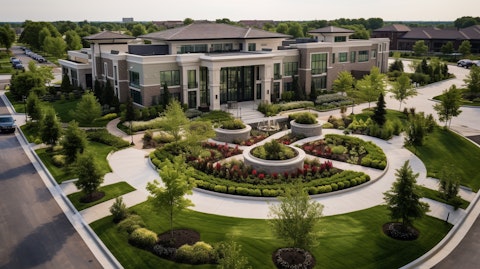LTC Properties, Inc. (NYSE:LTC) Q4 2023 Earnings Call Transcript February 16, 2024
LTC Properties, Inc. isn’t one of the 30 most popular stocks among hedge funds at the end of the third quarter (see the details here).
Operator: Greetings. Welcome to the LTC Properties, Inc. Fourth Quarter 2023 Earnings Call. [Operator Instructions]. Before management begins its presentation, please note that today’s comments, including the question-and-answer session, may include forward-looking statements subject to risks and uncertainties that may cause actual results and events to differ materially. These risks and uncertainties are detailed in LTC Properties’ filings with the Securities and Exchange Commission from time-to-time, including the company’s most recent 10-K dated December 31, 2023. LTC undertakes no obligation to revise or update these forward-looking statements to reflect events or circumstances after the date of this presentation. Please note, this event is being recorded. I would now like to turn the conference over to Wendy Simpson.
Wendy Simpson: Thank you, operator, and welcome everybody to LTC’s 2023 fourth quarter conference call. I am joined today by Pam Kessler, Co-President and Chief Financial Officer and Clint Malin, Co-President and Chief Investment Officer. 2023 was a year of solid execution. So I want to begin by recognizing our very talented LTC team. During the year, we completed $262 million in investments and generated $77 million in sales proceeds, the sales resulted in net gains totaling $37 million. Additionally, we received $11.8 million in mezzanine loan payoffs, generating $1.6 million of exit IRR income at a weighted average rate of 12%. From an operational perspective, we successfully transitioned the Brookdale portfolio resulting in anticipated revenue of $0.5 million more than we generated from the original lease.
We received full contractual 2023 interest from Prestige with expectations for full contractual payments through at least 2025. Clint will further discuss this shortly, and importantly, we significantly reduced our leverage ahead of street expectations. From an industry perspective, demand for seniors housing is strong. Occupancy has increased for 10 consecutive quarters. And according to NIC, seniors housing occupancy rates are now on track to recover to pre-pandemic levels in the second half of this year, especially as new construction remains muted. While we are not in the prediction game, we are encouraged by what we’re seeing. Market fundamentals currently favor REITs with billions of dollars of financing maturities coming due interest rates influx and banks being more selective about their investments, particularly in real estate and for properties that are not currently generating positive cash flow.
We have been preparing for this environment by developing creative financing structures, including those with shorter maturities. We believe LTC’s creativity and flexibility makes it easier for us to act quickly by providing customized financing solutions based on an operator’s needs. Finishing up now with some LTC-specific metrics, the FAD payout ratio for the fourth quarter was 79%. We also maintained our monthly dividend payout of $0.19 per share. For the 2024 first quarter, we anticipate that FFO will be in the range of $0.69 to $0.70 per share. FFO excluding non-recurring items, will be in the range of $0.63 to $0.64 per share. The decrease between FFO and FFO, excluding non-recurring items, is due to the repayment of rent related to a property sale in January.
Pam will provide details shortly. We’re entering 2024 with a stronger, more diversified portfolio and a stronger balance sheet, better positioning LTC for future growth. Now I’d like to turn things over to Pam.
Pam Kessler: Thank you, Wendy. All numbers I’m going to discuss today are for the fourth quarter of 2023 compared with the fourth quarter of 2022, unless otherwise stated. Total rental revenue decreased by $2.2 million, principally related to portfolio transition, Anthem Street payment in 2022 of a temporary rent reduction and property sales. This was partially offset by revenue from an acquisition completed in the second quarter of 2023, annual rent escalations and lease renewals and extensions. Interest income from sale leaseback financing increased $2.4 million, mainly due to the acquisition of 11 assisted living and memory care communities during the 2023 first quarter accounted for as a financing receivable in accordance with GAAP.
Interest income from mortgage loans increased $1.8 million, primarily due to mortgage loan originations in the first quarter of 2023. Interest expense increased by $3.6 million, primarily due to a higher outstanding balance on our revolving line of credit and higher interest rates. Draws on our line of credit were used primarily to pre-fund 2023 investments. Interest expense was partially offset by scheduled principal paydowns on our senior unsecured notes. We recognized a $16.8 million gain on the sale related to the divestiture of 9 assisted living communities, which I’ll discuss shortly. Our provision for credit losses increased by $4.2 million, primarily due to a $3.6 million write-off of a working capital note pursuant to a 12-property assisted living master lease with ALG.
Additionally, we recorded an impairment loss of $3.3 million related to 7 of the Texas properties covered under this lease. Clint will provide additional detail later in the call. Transaction fees increased approximately $0.5 million related to lease transitions and amendments. Net income available to common shareholders increased by $10.2 million primarily due to the increase in gain on sale and higher interest income from new investments, partially offset by higher interest expense, the previously discussed impairment loss and increase in our provision for credit losses as well as the decrease in rental income. Fully diluted FFO per share was $0.57 compared with $0.72. Excluding non-recurring items, which represents the write-off of the working capital note, FFO per share was $0.66 compared with $0.72.
The decrease in FFO, excluding non-recurring items, was due to higher interest expense, lower rental income and additional shares outstanding from sales under our ATM program, partially offset by higher interest income from new investments. Now I’ll recap our recent divestitures. In total, we sold 9 properties with a combined 408 units for $29.6 million. We received proceeds of $24.6 million net of transaction costs and seller financing and recorded gains of approximately $17 million, 8 of the properties were part of our previously disclosed Brookdale transactions. Subsequent to the end of the fourth quarter, we sold our JV interest in a 110-unit assisted living community located in Wisconsin for $23.1 million, which yielded 8.12% to LTC in 2023.
The purchase price includes the repayment of $2.4 million of rent credits given to the operator during new construction lease up and the payoff of a $550,000 working capital note. We received net proceeds of $19.6 million net of transaction costs, and we anticipate reporting a gain on sale of $4 million in the 2024 first quarter. With the repayment of the risk credits, we effectively received full 2024 rental income during the first quarter. However, in order to provide first quarter FFO guidance, we normalized this $2.4 million of rent as a non-recurring item. Also during the fourth quarter, we sold approximately 1.6 million shares of common stock for net proceeds of $52 million under our ATM program. Subsequent to the end of the quarter, we sold approximately 91,000 shares of common stock for net proceeds of $2.9 million under the program.
During the fourth quarter, we repaid $5 million in scheduled principal paydowns on our senior unsecured notes and paid $24 million in common dividends. Importantly, we repaid $60 million under our unsecured revolving line of credit, reducing our debt to annualized adjusted EBITDA for real estate from 6x for the 2023 third quarter to 5.5x for the 2023 fourth quarter. Subsequent to the end of the quarter, we repaid $30.5 million under our unsecured revolving line of credit, reducing our 2023 fourth quarter debt to adjusted EBITDA per real estate ratio from 5.5x to 5.4x on a pro forma basis. As Wendy mentioned earlier, by substantially reducing our leverage, LTC is better positioned for growth in 2024 and in the future. Additionally, subsequent to the end of the quarter, we amended our unsecured revolving line of credit to accelerate the 1-year extension option notice date and exercised our option to extend the maturity date to November 19, 2026.

All other provisions of the agreement remain unchanged. Currently, we have $15 million of cash on hand, approximately $128 million available on our line of credit with roughly $272 million outstanding and about $73 million available under our ATM. This gives us total liquidity of almost $217 million. Now I’ll hand the mic over to Clint.
Clint Malin: Thank you, Pam. I’ll begin with a discussion of some of our operating partners, starting with Brookdale. Aside from the 8 properties sold from the original portfolio, Brookdale retained 17 of the properties under a new master lease. 5 properties were transitioned to an existing LTC operator, Oxford Senior Living, and fiber transition to an operator new to LTC, Navion Senior Solutions. Compares repeating that through these successful transactions, we have more than replaced the income that was generated from the original Brookdale portfolio through a combination of new leases and pre-investing sales proceeds. Next, I’ll discuss a 12-property nonrevenue-generating portfolio which has temporarily transitioned to ALG in July 2022 following the COVID pandemic.
ALG provided assistance by stepping out of their geographic footprint to quickly support us by operating these properties while we evaluated whether to sell them or transition them or some combination of both. This 12-property ALG master lease included 8 properties in Texas and 1 each in Florida, Georgia, Mississippi and South Carolina. The majority of these properties are primarily located in small towns and were built in the 1990s. We sold the Florida and Mississippi communities during 2023. For the remaining 10 properties, we entered into an agreement to sell 5 of the Texas properties, closed a building in Texas during 2023 and plan to close a second Texas property in the near future. We then expect to sell the 2 closed properties for alternative uses.
After the end of the fourth quarter, we transitioned 2 properties that were built in the last 5 to 7 years in Georgia and South Carolina to an operator new to LTC, the Legacy Senior Living. The lease term is for 2 years and with two 1-year extension options. Initial rent for the first 6 months is zero, after which it will be based on mutually agreed-upon fair market rent. The master lease includes a purchase option that can be exercised in 2027 if the two 1-year lease extensions are exercised. Additionally, we agreed to fund up to $900,000 for capital expenditures for the first year of the lease and up to $240,000 for a working capital note at 8.25% maturing on December 31, 2025. We are currently working to transition the remaining property.
To reiterate, the portfolio was non-revenue generating. A few words about Prestige Healthcare. As we previously disclosed, we amended Prestige’s mortgage loan, which is secured by 15 skilled nursing centers in Michigan. Effective January 1, 2024, the minimum mortgage interest payment due to LTC is based on an annual current pay rate of 8.5% on the outstanding loan balance of $183 million. Contractual interest rate on the loan, 10.8% remains unchanged. Additionally, the amendment gives LTC the right to draw on Prestige’s security, pay the difference between the contractual rate on the loan and the current pay rate. We received all 2023 contractual interest up $19.5 million due from Prestige including drawing $3.4 million of security held by us.
Subsequent to the end of the 2023 fourth quarter, Prestige increased our security using retroactive Medicaid payments received from the State of Michigan. We currently hold security of $4 million and expect that additional retroactive Medicaid payments to be received by Prestige later in 2024 will be remitted to LTCS security. Full contract interest has been paid on the loan through February 2024, and we expect to receive full contractual interest through at least 2025, including draws as needed from the security provided by the retroactive Medicaid payments. Improvement in the performance of the properties will reduce the need to apply security held by us. Occupancy in this portfolio grew from 73% in September to 75% in January. Regarding our fourth quarter investment activity, we mentioned during the last quarter’s call that we closed on a transaction to fund a $19.5 million mortgage loan at a yield of 8.25% for the construction of an 85-unit assisted living and memory care community in Michigan.
The borrower’s equity has been fully drawn, so we began funding in the first quarter of this year. Moving on to our assisted living portfolios with quarterly market-based rent resets which now include the 2 assisted living communities for whom we have been providing abated rent, we received 861,000 during 2023 and expect to receive $3.3 million in 2024. For our SNF portfolio transition to HMG, we received $8 million in rent during 2023. Subsequent to December 31, 2023, we amended the master lease to extend its term from February 1, 2024, to August 31, 2024. Rent was set at $4.7 million for the period, which annualizes to $8 million. We also extended the term of HMG’s revolving line of credit to coincide with the new lease expiration. Next, I’ll provide insight into our portfolio numbers, which excludes properties transitioned on or after July 1, 2022.
Q3 trailing 12-month EBITDARM and EBITDAR coverage as reported using a 5% management fee was 1.23x and 0.99x, respectively for our assisted living portfolio. Excluding stimulus funds received by our operators, coverage was 1.14x and 0.9x, respectively. For our skilled nursing portfolio, as reported EBITDARM and EBITDAR coverage was 1.96x and 1.47x, respectively, excluding stimulus funds received by our operators, coverage was 1.68x and 1.19x, respectively. Pro forma for the 4% Medicare market basket rate increase skilled nursing EBITDAR coverage, excluding stimulus funds, would have been 1.24x. Now for some recent general occupancy trends, which are as of January 31 and are for our same-store portfolio. These numbers include approximately 65% of our total same-store private pay units and approximately 78% of our same-store skilled nursing beds.
Private pay occupancy was 87% at January 31, 2024, 87% at September 30, 2023, and 85% at June 30. For our skilled nursing portfolio, average monthly occupancy was 76% in January, 75% in both September and June. As for the pipeline, we are working to rebuild it with accretive and strategic investments. The majority of our investments during 2024 are expected to be back-end loaded. In terms of how we’re thinking about the current market and potential opportunities, bank maturities will likely be in the billions of dollars this year and in many cases, banks are highly selective and only will work with existing customers that are willing and able to put up higher reserves. The bottom line for LTC is that we believe we are in a good position to grow and further diversify our portfolio.
We believe our structured finance platform offers interesting solutions to complement triple net acquisitions and joint ventures. And that as a result of the current lending environment, we can grow relationships with the regional operators with whom we don’t already have a relationship. Now I’ll turn the call back to Wendy for her closing remarks.
Wendy Simpson: Thank you, Pam and Clint. After some major accomplishments in 2023 and strengthening our portfolio and balance sheet, we believe LTC is well positioned to capture current opportunities. Thank you, everyone. We appreciate your continued support, and we’ll talk to you again next quarter. Operator, we are now ready to take questions.
See also Jim Cramer’s Top 10 Stock Picks This Week and 17 Fastest growing B2B SaaS Companies.
Q&A Session
Follow Ltc Properties Inc (NYSE:LTC)
Follow Ltc Properties Inc (NYSE:LTC)
Operator: [Operator Instructions] Your first question for today is coming from Austin Wurschmidt with KeyBanc Capital Markets.
Austin Wurschmidt: Just wanted to first hit on the first quarter guidance. And just curious what the biggest factors are driving the delta between what you achieved in the fourth quarter? And the guidance that you put out for the first quarter, I think, $0.63, $0.64?
PamKessler: Hi, Austin. It’s Pam. It’s primarily coming from a decrease in revenue from properties sold and then the dilution from the ATM issuance.
Austin Wurschmidt: Got it. Is there anything from an excess rent payment that’s also having an impact there from — you received over 100%, I believe, in the fourth quarter. Just curious how much of an impact there is or any other considerations in the first quarter as we think about then the run rate through the balance of the year?
PamKessler: Right. So we did normalize in the first quarter and the guidance, we did normalize the year of rent that we received for the property that was sold. And then in the fourth quarter, I think you’re referring to the Prestige deferred interest, we received $1.5 million. That was recorded on the effective interest method, which is essentially straight line for interest income. So there was no effect from that in FFO. In FAD, yes, there’s a pickup of $1.5 million, but in FFO, there was nothing that would change that run rate.
Austin Wurschmidt: Got it. That’s helpful. And then just switching over to the HMG portfolio. You guys have talked a lot about this, pushing out the lease on a sort of temporary basis, but what are sort of the thoughts on how you plan to keep the assets in the current master lease, or are you still considering selling some of those assets? And then as it stands today, I mean, can you kind of put a little bit of a ring fence around or book end where you think potential upside is currently within that lease? And then is there even further upside if the reimbursement environment is more favorable than today?
Clint Malin: Sure. This is Clint. Well, one of the items for doing the 7-month extension is HMG has asked us to look at retenanting or selling 2 of the properties. So we’re going through that evaluation right now, and that was the primary reason for extending just for 7 months. We do believe there is upside in this portfolio. We’re not sure exactly of the timing and how much, but we do believe there is definitely room that we should be participating in the cash flow on this. So to set a more permanent rent where we have constant rent growth.
Austin Wurschmidt: Even if you sell those 2 assets, can the remaining —
Clint Malin: Well, these 2 assets, whether we sell a retenant, they are currently collectively positive cash flow. So it’s not that they are a negative drain to HMG, it’s maybe more geographic based. So I think that gives us optionality.
Austin Wurschmidt: Got it. But do you think you can sustain the $8 million run rate then if those 2 assets get sold or…
Clint Malin: Yes. I think on a net basis, we sell the assets and what we could redeploy those dollars at. I think on a net basis, yes, we would be at the $8 million at a minimum.
Austin Wurschmidt: Okay. That’s helpful. And then just last one for me. I’m just curious, you guys were active on the ATM this quarter, brought down leverage. I mean should we expect that you want to continue to drive down leverage? Or would you think about further deleveraging from here more so from overequitize on future investments?
PamKessler: Yes, probably the latter. We have some loans, if you look at the maturity, the loan receivable maturity schedule in the supplemental. We have about $80 million coming due to us this year. So that naturally deleverages us down to 5x by the end of the year, which is around our long-term target. But yes, we would look to overequitize investments as well.
Operator: Your next question is from Rich Anderson with Wedbush.
Rich Anderson: On the ALG portfolio, that was paying you zero, correct, Clint, prior to all of these?
Clint Malin: Correct. Prior to the transition to ALG, it was paying us zero.
Rich Anderson: Okay. And so now you go through all these steps, do I have this right, you’ll be left with probably two operating assets?
Clint Malin: So we’ll be left with three. So two, we’ve already transitioned to a new operator at the end of the year. And then we have 1 remaining property to transition. And those 3 buildings are the newer buildings of the 12-property master lease.
Rich Anderson: Two to legacy and one to go?
Clint Malin: Correct.
Rich Anderson: And zero rent for the first 6 months on those two?
Clint Malin: Correct.
Rich Anderson: Okay. So there’s no downside in 2024 from this then, right? If you get anything from those three, it’s positive?
Clint Malin: As I emphasize on the call, non-revenue generating. Correct.
Rich Anderson: Okay. And then on Prestige, you collected the 19 5 including, I think, you said a $3.4 million draw last year. They’ve added to that and replenished that through the retroactive Medicaid. Did you say how much more your security deposit is now? And that’s question number one.
Clint Malin: Sure. We were at $5 million previously. We’re now at $4 million after we drew on the letter of credit and then they replenished the letter of credit. So net change down $1 million were current on contractual interest through February of 2024.
Rich Anderson: Okay. So that contractual interest is some combination of real payment, interest payment and draws, future draws in security, correct?
Clint Malin: Correct. The current pay is 8.5%. And then, we can draw on the security to reach the contractual interest payment.
Rich Anderson: Okay. And when do you think that you kind of get away from security deposit draws?





